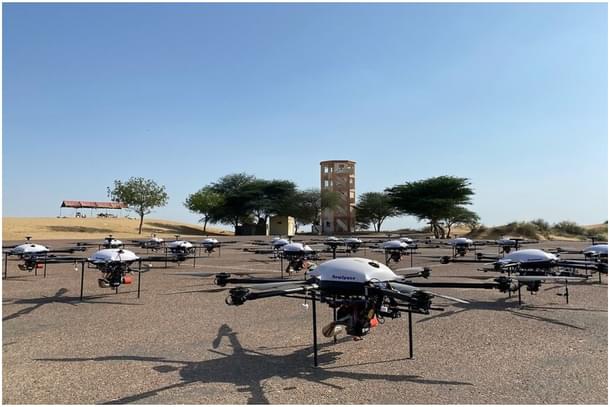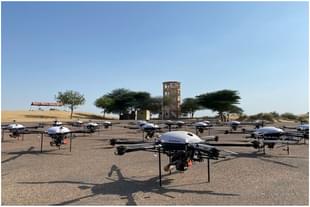Defence
Loiter, Strike, Repeat: Inside India’s Drone Army For The Next Border Clash
Swarajya Staff
Apr 30, 2025, 03:17 PM | Updated 03:58 PM IST
Save & read from anywhere!
Bookmark stories for easy access on any device or the Swarajya app.


The battlefield is changing, and so is India’s approach to war.
Along the rugged ridge-lines of the Himalayas and the tense stretches of the western border, the Indian Army is rethinking how it prepares for the next conflict. Tanks, artillery, and infantry still matter—but increasingly, it’s the unmanned, hovering machines in the sky that are drawing the most attention. Drones are no longer a futuristic accessory to warfare—they are fast becoming central to it. The world saw it in Ukraine.
Earlier this year, India’s Defence Research and Development Organisation (DRDO) and Bharat Electronics Limited (BEL) successfully tested the Integrated Drone Detection and Interdiction System (IDD&IS)—a laser-based setup meant to take down hostile drones along the Line of Actual Control with China. With jamming capabilities at a range of 2–5 km and laser kills up to 800 meters, the system is one response among many to a growing challenge: securing Indian airspace from increasingly frequent drone incursions.
Recent wars—especially the ongoing Russia-Ukraine conflict—have underlined how deeply unmanned systems have changed the nature of combat.
Cheap, agile, and expendable, drones have been used in massive numbers for everything from surveillance and artillery correction to direct strikes and even propaganda. Military planners across the world have taken note—and India is no exception.
Over the past few years, the Indian Army has been steadily expanding its drone fleet, acquiring systems to match evolving threats, especially from across the Line of Control. Pakistan, too, has serious drone capabilities, backed by Chinese-supplied CH-4s and Turkish Bayraktar TB2s, along with cheep, improvised, commercially-available machines built for civilian use, some of which it has provided to its terror outfits.
From loitering munitions to swarm drones, many of these platforms are being developed under the Aatmanirbhar Bharat push, while others are imported or produced through joint ventures. Together, they represent a new phase in the Indian Army’s modernisation—not one of dramatic leaps, but of quiet, calculated adjustments.
Here are some such weapons that could come into play if the rising tensions between India and Pakistan post Rawalpindi's Pahalgam gamble turn into active hostilities.
1. Nagastra-1
Maker: Solar Industries India, in collaboration with Z-Motion Autonomous Systems Pvt Ltd.
Inducted/Ordered: Indian Army has 480 units as of December 2024
Role and Capabilities: Weighing just 9 kg, the Nagastra-1 is a man-portable, fixed-wing electric UAV designed for tactical precision and stealth. With a flight endurance of 30 minutes, it offers a 15 km range under man-in-the-loop control, extendable to 30 km in autonomous mode. Its electric propulsion enables a low acoustic signature, making it nearly undetectable at altitudes above 200 metres.
Armed with a 1 kg high-explosive fragmenting warhead designed to neutralise soft-skin targets, the UAV is also equipped with day and night surveillance cameras for round-the-clock intelligence gathering. Unique among its class, the system allows for mission abort, in-flight recovery, and reuse via a parachute recovery mechanism.

Developed with over 75 per cent indigenous components in partnership with Bengaluru-based Z-Motion Autonomous Systems Pvt Ltd, the entire Nagastra-1 system, including the UAV, ground control station, communication control, payload, and pneumatic launcher, is compactly split across two rucksacks with a total weight of 30 kg, ensuring maximum portability for frontline deployments.
2) ALS-50
Maker: Tata Advanced Systems Limited
Inducted/Ordered: In service since 2024; 100 inducted
Role and Capabilities: The ALS-50 is an indigenous loitering munition with a 50 km range, 1 and 1-hour endurance. Featuring anti-jamming capabilities and a 50 kg payload, it is designed for precision strikes in GNSS-denied environments. Its compact design allows for rapid deployment, making it ideal for targeting Pakistani forward posts or supply lines. In a conflict, the ALS-50 could disrupt logistics and communications, leveraging its autonomous operation to strike with high accuracy, even under electronic warfare conditions.

3) SWITCH UAV (Advanced Tactical ISR Drone)
Maker: ideaForge (Mumbai-based drone manufacturer)
Inducted/Ordered: Contract worth $20 million (around Rs 140 crore) awarded for an undisclosed number; deliveries to be completed within one year
Role and Capabilities: The SWITCH UAV is a high-altitude capable, man-portable fixed-wing drone with Vertical Take-off and Landing (VTOL) capability. Designed for frontline infantry and Special Forces, particularly in contested regions like Ladakh, the drone is tailored for Intelligence, Surveillance and Reconnaissance (ISR) missions in extreme weather and terrain. Weighing 6.5 kg, the standard SWITCH has a 2-hour endurance and 15 km operational range from heights up to 4,000 metres.

The Army has ordered a more advanced variant with encrypted communications, extended endurance, HD optical payload with long-range target detection, and the ability to cover 700 sq km per launch. SWITCH emerged as the sole drone to pass the Army’s rigorous evaluations, beating competition from suppliers like Israel’s Elbit.
4) Trinetra
Maker: AeroArc (Indianised version of Skydio drone, USA)
Inducted/Ordered: Nearly 700 ordered by Indian Army
Role and Capabilities: Trinetra is an autonomous surveillance drone developed to meet the unique operational challenges faced by Indian forces in high-altitude and forested regions like Jammu and Kashmir. Adapted for extreme temperatures ranging from -40°C to +55°C and high elevations, Trinetra features six navigation cameras and two thermal cameras that allow obstacle avoidance and target detection without a visual line of sight.

Originally developed by Skydio and used by the US Department of Defense and Ukrainian forces, the platform has been locally tailored by Coimbatore-based AeroArc. While it faced performance issues in Ukraine under Russian electronic warfare, its Indianised variant is optimised for GPS-denied and EW-heavy environments, enhancing Army surveillance and reconnaissance capabilities in hostile terrain.
5) Swarm Drone System (Heterogeneous High-Density Swarm)
Maker: NewSpace Research & Technologies (Bengaluru-based startup)
Inducted/Ordered: 100 swarm drone units inducted
Role and Capabilities: This is India’s first operational heterogeneous swarm drone system, capable of autonomous massed attacks up to 50 km into enemy territory. Each swarm comprises 100 drones working cooperatively without a central controller, using advanced AI, autonomy, and edge computing. Designed to operate in contested airspace, the drones carry small bombs and can self-organise, adapt formations, and continue missions even after partial losses.
Intended for use against armoured columns, artillery positions, and bunkers, the swarm system provides overwhelming saturation attacks, imposing high costs on enemy air defences. Originally conceived through the IAF’s 2018 Mehar Baba competition, the programme marks a global first in operational high-density swarming UAS induction. The Army has begun fielding them in mechanised units, with the IAF expected to follow.
6) FPV Kamikaze Drone (Explosive Payload UAV)
Maker: Developed jointly by the Indian Army’s Fleur-De-Lis Brigade and Terminal Ballistics Research Laboratory (TBRL), Chandigarh
Inducted/Ordered: First trial batch of 5 inducted; 95 more under procurement as of March 2025
Role and Capabilities: This indigenous First-Person View (FPV) kamikaze drone, a first for the Indian Army, is equipped with a 400-gram shaped charge capable of piercing tank armour. Such a drone would be of much use to the Indian Army if it were to cross the international border into Pakistan. Costing only Rs 1.4 lakh per unit, it is inspired by battlefield successes in Ukraine and offers a low-cost alternative to imported systems like the US Switchblade and Israel’s Harop.

Assembled at the Army’s Rising Star Drone Battle School, it is tailored for tactical missions with real-time relay systems for precision targeting. Rigorously tested in Pathankot, this system includes dual-safety features and FPV-controlled detonation, making it a reliable, scalable solution for high-impact strikes.
7) Black Hornet
Maker: FLIR Systems (now Teledyne FLIR), USA.
Inducted/Ordered: Inducted 100; 200 more approved
Role and Capabilities: The Black Hornet is a nano-drone weighing just 33 grams, designed for squad-level surveillance and reconnaissance. With a 2 km range and 25-minute endurance, it provides real-time video feed for urban and rugged terrain operations. In a conflict with Pakistan, Black Hornets could be deployed by infantry units to scout terrorist hideouts or monitor LoC crossings, reducing soldier exposure.

Its stealth and portability make it a critical asset for situational awareness in contested areas. In January 2025, the Army announced plans to procure an additional 200 units of the drone
8) Warmate
Maker: WB Group, Poland.
Inducted/Ordered: Reportedly 100 inducted
Role and Capabilities: The Warmate is a lightweight loitering munition with a 30 km range and a 1.4 kg warhead, designed for precision strikes against personnel and light vehicles. Its portability and 50-minute loiter time make it suitable for rapid-response missions. In a Pakistan conflict, Warmate drones could target militant groups or small-scale fortifications, offering a low-cost, high-impact solution. Its testing in Ladakh highlights its suitability for high-altitude operations along the LoC.

Its modular design allows for quick deployment by special forces and seamless integration with onboard vehicle systems, including the Ground Control Station and Ground Data Terminal.
The drone is fully autonomous, providing real-time video feeds for battlefield awareness and incorporating advanced control modules that automate most flight phases while assisting the operator with targeting tasks. Despite its autonomous capabilities, the operator retains full control and is solely responsible for activating.





